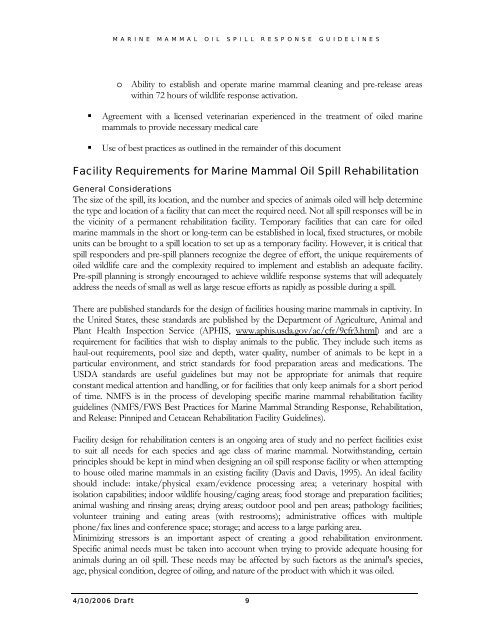Volume III, Appendices EM - National Marine Fisheries Service ...
Volume III, Appendices EM - National Marine Fisheries Service ...
Volume III, Appendices EM - National Marine Fisheries Service ...
Create successful ePaper yourself
Turn your PDF publications into a flip-book with our unique Google optimized e-Paper software.
MARINE MAMMAL OIL SPILL RESPONSE GUIDELINES<br />
o Ability to establish and operate marine mammal cleaning and pre-release areas<br />
within 72 hours of wildlife response activation.<br />
Agreement with a licensed veterinarian experienced in the treatment of oiled marine<br />
mammals to provide necessary medical care<br />
Use of best practices as outlined in the remainder of this document<br />
Facility Requirements for <strong>Marine</strong> Mammal Oil Spill Rehabilitation<br />
General Considerations<br />
The size of the spill, its location, and the number and species of animals oiled will help determine<br />
the type and location of a facility that can meet the required need. Not all spill responses will be in<br />
the vicinity of a permanent rehabilitation facility. Temporary facilities that can care for oiled<br />
marine mammals in the short or long-term can be established in local, fixed structures, or mobile<br />
units can be brought to a spill location to set up as a temporary facility. However, it is critical that<br />
spill responders and pre-spill planners recognize the degree of effort, the unique requirements of<br />
oiled wildlife care and the complexity required to implement and establish an adequate facility.<br />
Pre-spill planning is strongly encouraged to achieve wildlife response systems that will adequately<br />
address the needs of small as well as large rescue efforts as rapidly as possible during a spill.<br />
There are published standards for the design of facilities housing marine mammals in captivity. In<br />
the United States, these standards are published by the Department of Agriculture, Animal and<br />
Plant Health Inspection <strong>Service</strong> (APHIS, www.aphis.usda.gov/ac/cfr/9cfr3.html) and are a<br />
requirement for facilities that wish to display animals to the public. They include such items as<br />
haul-out requirements, pool size and depth, water quality, number of animals to be kept in a<br />
particular environment, and strict standards for food preparation areas and medications. The<br />
USDA standards are useful guidelines but may not be appropriate for animals that require<br />
constant medical attention and handling, or for facilities that only keep animals for a short period<br />
of time. NMFS is in the process of developing specific marine mammal rehabilitation facility<br />
guidelines (NMFS/FWS Best Practices for <strong>Marine</strong> Mammal Stranding Response, Rehabilitation,<br />
and Release: Pinniped and Cetacean Rehabilitation Facility Guidelines).<br />
Facility design for rehabilitation centers is an ongoing area of study and no perfect facilities exist<br />
to suit all needs for each species and age class of marine mammal. Notwithstanding, certain<br />
principles should be kept in mind when designing an oil spill response facility or when attempting<br />
to house oiled marine mammals in an existing facility (Davis and Davis, 1995). An ideal facility<br />
should include: intake/physical exam/evidence processing area; a veterinary hospital with<br />
isolation capabilities; indoor wildlife housing/caging areas; food storage and preparation facilities;<br />
animal washing and rinsing areas; drying areas; outdoor pool and pen areas; pathology facilities;<br />
volunteer training and eating areas (with restrooms); administrative offices with multiple<br />
phone/fax lines and conference space; storage; and access to a large parking area.<br />
Minimizing stressors is an important aspect of creating a good rehabilitation environment.<br />
Specific animal needs must be taken into account when trying to provide adequate housing for<br />
animals during an oil spill. These needs may be affected by such factors as the animal's species,<br />
age, physical condition, degree of oiling, and nature of the product with which it was oiled.<br />
4/10/2006 Draf t 9
















